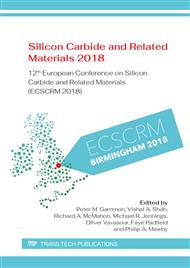p.479
p.485
p.490
p.494
p.498
p.502
p.506
p.511
p.516
Optimization of Ni/Nb Ratio for High-Temperature-Reliable Ni/Nb Silicide Ohmic Contact on 4H-SiC
Abstract:
Low specific contact resistivity and high-temperature reliability of the Ni (x)/Nb (100-x) (where x = 25, 50, 75 nm) ohmic contact to 4H-SiC were investigated. After the annealing process at 1000°C for 3 min in N2 ambient, the I-V curves indicated that all the contacts exhibited the ohmic behaviors. Based on the transfer length method, the specific contact resistivity of the contacts were extracted. High concentration of Ni was responsible for low specific contact resistance of the Ni (75)/Nb (25)/4H-SiC sample by the formation of Ni2Si compound after the fabrication process. However, this contact lost the ohmic behavior at low temperature of 150°C. Whereas, both Ni (50)/Nb (50)/4H-SiC and Ni (25)/Nb (75)/4H-SiC contacts remained the ohmic behavior for 100-hour aging at 400°C. Two-dimensional X-ray diffraction analyses showed that the presence of carbon agglomeration formed at the interface of the Ni (75)/Nb (25)/4H-SiC contact caused the degradation of this sample when being aged at high temperature environment. Meanwhile, higher concentration of Nb in the Ni (50)/Nb (50)/4H-SiC and Ni (25)/Nb (75)/4H-SiC samples improved the ability to collect the excess carbon atoms and thus enhanced the high temperature reliability of these contacts when operating in high temperature ambient. Considering both low specific contact resistivity and high temperature reliability, the Ni (50)/Nb (50)/4H-SiC contact can be a good candidate for harsh environment applications.
Info:
Periodical:
Pages:
498-501
Citation:
Online since:
July 2019
Price:
Сopyright:
© 2019 Trans Tech Publications Ltd. All Rights Reserved
Share:
Citation:


